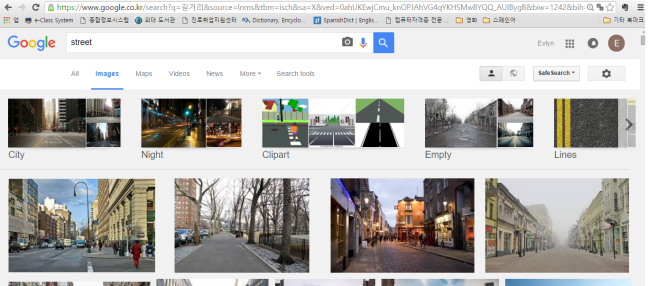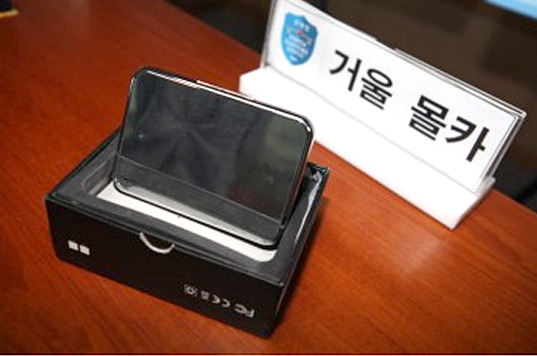If you google the word ‘street’ in Korean, all of the images contain women walking down the streets, most of them wearing clothes that reveal their body. Meanwhile, if you google ‘street’ as it is in English, it shows plain pictures of the streets with buildings and roads. The purpose of the pictures is obvious; the angle of the pictures, emphasizing legs and hip. Knowing that the search engine shows the most popular results, it is reasonable to assume that Korean users preferred these images over a pictures of a plain old street. This stark difference in search results demonstrates the widespread voyeurism on the internet in Korea.

Figure 1. Google ‘street’ in Korean (Kim, 2015).

Figure 2. Google ‘street’ in English (Kim, 2015).
In October, a video showing the women’s shower room of Caribbean Bay, a water park, was released on the Internet. The video revealed the bodies of innocent women in there without editing. The link of the video was scattered through the SNS and the fact that such crime was committed at a public place shocked the internet users. The incident was the ignition for the public to recognize the act of voyeurism on the internet that remained undercurrent. It also stoked criticism that there should be some measures to prevent such crimes.
In Korea, the crime to take pictures of private parts of women is called molka, which is short for the expression to take pictures discretely. The molka crime varies from taking pictures with their phones in the subway to installing hidden cameras in public toilets or changing rooms. According to the Korean National Police Agency, the crime has sextupled over the last five years with the total of 6623 cases last year. Averaged, it is 18 cases per day (Park, 2015). Although total number of criminal cases and violent crimes such as murder or armed robbery in Korea have reduced for the first time in five years, the number of sex crimes have exceeded the maximum point. Among them, molka crime has increased dramatically. The crime took about three percent in 2005 in total sex crimes, but last year the rate has increased to 24.1 percent (Yang, 2015).
The ways to take pictures or recordings have evolved in a malicious way. The molka crime could be largely divided into two types. One is to take pictures on the subway manually and the other is to record videos from pre-installed hidden cameras in toilets. Smartphone is usually used to take pictures, but there were many other gadgets sold for the purpose. There were watches, ball-point pens, and even camera-installed shoelace according to the Police (MBC, 2015). For the latter purpose, pre-installed hidden cameras were widely used. Mirrors were even used to record the videos of women coming out of the toilets (Kwon, 2015).

Figure 3. Watch-Camcorder with full HD resolution (Park, 2015).

Figure 4. Camera-installed Mirror (Kwon, 2015).
It is perceived that the cause in the rapid growth in molka crime is the widespread use of smartphones. Smartphones provide an environment where it is easier to access the secretely taken videos that are scattered around the internet. If one constantly watches the video, it could increase the desire for the viewer to peep inside one’s private life themselves.
A university student surnamed Ahn said that he had a chance to come across the video accidentally while downloading a file for his paper. At first encounter he did not feel anything, but after watching those videos for some time he was sexually stimulated by them and even felt the urge to do it himself (Park, 2015).
In response to the heightened crime rate and fear among the public, the government implemented a measure to give reward to those who reported suspicious activities regarding molka. The reward is up to 20 million won on serial, organized cases, 10 million on cases with commercial purposes and a million won for personal use. After the incident with the water park on October, eight people reported molka cases and took the reward (Kang, 2015).
For another measure, the government shut down a website called ‘Soranet’ which was blamed to be the epicenter of such crimes. The website was infamous for sexual promiscuity as the users posted texts and pictures of unconventional sexual acts like swapping. However, shutting down a website is merely a knee-jerk reaction because the members of the website does not stop the acts even if they do not have an agora of sex. Instead they form small groups in other websites and carry on with what they were doing in their new home.
As discussed, it is evident that the environment allowed the crime to flourish, it is not the only thing that should take the blame. The bottom line is that the phenomenon reflects sexism in Korean society, and it is manifesting as a crime spree.
In a study on ambivalent sexism in Korean society, it was revealed that women were relatively less resistant toward sexism beneath the surface, or benevolent sexism than more expressive and hostile sexism.
This result demonstrates that the existing studies that showed benevolent sexism appears among women in countries where sexism is prevalent. The study also demonstrated that both hostile and benevolent sexism are still prevalent among men, compared to women. Further, it was also appeared that men are less compassionate toward the victims of sex crimes (Seo, 2015).
The increase in smartphone use may be an ignition for the molka crimes. However, the underlying cause is more associated with sexism rampant in Korean society. It is not about legislation, but more of an issue of a cultural lag where the people cannot follow the development of the system. In order to resolve the situation, it is necessary to check whether the education on sexual equality is effectively conducted or not. To eliminate sex crimes and promote gender equality, there should be a revision in education from the most fundamental level for consciousness on equality to root into Korean society.
Bibliography
- Kang, Y. (2015). Water Park Cam Incident, It Could Happen to Anyone. Retrieved December 18, 2015 from http://www.yonhapnews.co.kr/bulletin/2015/12/04/0200000000AKR20151204124400061.HTML?input=1195m
- Kim, N. (2015). Google ‘street’ in English. Retrieved December 17, 2015 from https://www.google.co.kr/search?q=street&source=lnms&tbm=isch&sa=X&ved=0ahUKEwjewqHfw-PJAhXDJ6YKHYoXBakQ_AUIBygB&biw=1242&bih=545
- Kim, N. (2015). Google ‘street’ in Korean. Retrieved December 17, 2015 from https://www.google.co.kr/search?q=street&source=lnms&tbm=isch&sa=X&ved=0ahUKEwjewqHfw-PJAhXDJ6YKHYoXBakQ_AUIBygB&biw=1242&bih=545#tbm=isch&q=%EA%B8%B8%EA%B1%B0%EB%A6%AC
- Kwon, Y. (2015). Molka Is a Weapon If Used Inappropriately… There Should Be a Registration System. Retrieved December 17, 2015 from http://news.naver.com/main/read.nhn?mode=LSD&mid=sec&sid1=102&oid=277&aid=0003583893
- MBC. (2015). Sexual Harassment On Subway. Retrieved December 17, 2015 from http://imnews.imbc.com/replay/2015/nw1800/article/3689753_17808.html
- Park, H. (2015). Watch Camcorder with full HD resolution. Retrieved December 17, 2015 from http://news.heraldcorp.com/view.php?ud=20151202000083
- Park, J. (2015). Korea, a Heaven for Molka crime. Retrieved December 18, 2015 from http://news.naver.com/main/read.nhn?mode=LSD&mid=sec&oid=020&aid=0002889816&sid1=001
- Park, S. (2015). Discrete Molka Crime and Raging Society Gives Birth to Violence. Retrieved December 17, 2015 from http://www.breaknews.com/sub_read.html?uid=407734§ion=sc2
- Seo, Y. (2015). Ambivalent sexism, hostile sexism, benevolent sexism, sexual offense, responsibility judgment. Retrieved December 18, 2015 from http://sproxy.hufs.ac.kr/bbd64ed/_Lib_Proxy_Url/kiss.kstudy.com/journal/thesis_name.asp?tname=kiss2002&key=3260836
Yang, D. (2015). Largest Number of Sex Crimes… Less Rapes, More Molka and Harassment. Retrieved December 17, 2015 from http://news.heraldcorp.com/view.php?ud=20151202000083